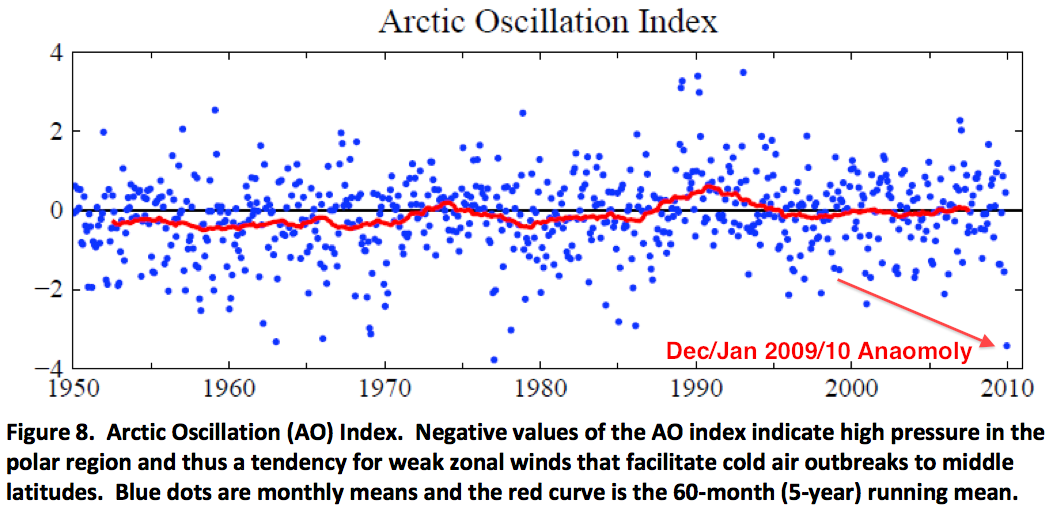Arctic Oscillation (AO)
The Arctic Oscillation (AO) is a large scale mode of climate variability, also referred to as the Northern Hemisphere annular mode. The AO is a climate pattern characterized by winds circulating counterclockwise around the Arctic at around 55°N latitude.
When the AO is in its positive phase, a ring of strong winds circulating around the North Pole acts to confine colder air across polar regions. This belt of winds becomes weaker and more distorted in the negative phase of the AO, which allows an easier southward penetration of colder, arctic air masses and increased storminess into the mid-latitudes.
AO index is obtained by projecting the AO loading pattern to the daily anomaly 1000 millibar height field over 20°N-90°N latitude. The AO loading pattern has been chosen as the first mode of EOF analysis using monthly mean 1000 millibar height anomaly data from 1979 to 2000 over 20°N-90°N.
Source: NOAA CPC’s AO page.
Some researchers are currently postulating about the possibility that increased warming may increase negative phase AO intensity. It will be interesting to see what is discovered in this area.
The Arctic Oscillation
The Arctic Oscillation refers to opposing atmospheric pressure patterns in northern middle and high latitudes.
The oscillation exhibits a “negative phase” with relatively high pressure over the polar region and low pressure at midlatitudes (about 45 degrees North), and a “positive phase” in which the pattern is reversed. In the positive phase, higher pressure at midlatitudes drives ocean storms farther north, and changes in the circulation pattern bring wetter weather to Alaska, Scotland and Scandinavia, as well as drier conditions to the western United States and the Mediterranean. In the positive phase, frigid winter air does not extend as far into the middle of North America as it would during the negative phase of the oscillation. This keeps much of the United States east of the Rocky Mountains warmer than normal, but leaves Greenland and Newfoundland colder than usual. Weather patterns in the negative phase are in general “opposite” to those of the positive phase, as illustrated below.
Over most of the past century, the Arctic Oscillation alternated between its positive and negative phases. Starting in the 1970s, however, the oscillation has tended to stay in the positive phase, causing lower than normal arctic air pressure and higher than normal temperatures in much of the United States and northern Eurasia.
Effects of the Positive Phase | Effects of the Negative Phase
of the Arctic Oscillation of the Arctic Oscillation
(Figures courtesy of J. Wallace, University of Washington)
Source: Arctic Oscillation (AO) – Period of Record Time series

Source: Arctic Oscillation (AO) – Time series since 2000
Arctic Oscillation: Observed & ENSM Forecasts

Source: https://www.cpc.noaa.gov/products/precip/CWlink/daily_ao_index/ao.shtml
Links
Document Actions



